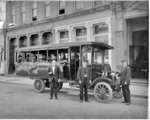At 8 a.m. on Monday morning, Jan. 19, Jefferson Transit’s Route No. 2 makes its 8 a.m. run to Fort Worden, marking 100 years – and one day – of continual transit service to the residents of …
This item is available in full to subscribers.
We have recently launched a new and improved website. To continue reading, you will need to either log into your subscriber account, or purchase a new subscription.
If you had an active account on our previous website, then you have an account here. Simply reset your password to regain access to your account.
If you did not have an account on our previous website, but are a current print subscriber, click here to set up your website account.
Otherwise, click here to view your options for subscribing.
* Having trouble? Call our circulation department at 360-385-2900, or email our support.
Please log in to continue |
|


At 8 a.m. on Monday morning, Jan. 19, Jefferson Transit’s Route No. 2 makes its 8 a.m. run to Fort Worden, marking 100 years – and one day – of continual transit service to the residents of Jefferson County.
It’s been a long historic road for public transportation.
In the decade of the 1890s and well into the 20th century, public transit in Port Townsend meant one of City Transfer’s horse-drawn taxi cabs.
Owner Sam McGee would later modernize his fleet of cabs when he purchased a 1910 Chalmers-Detroit and a 1912 REO touring car. Profits from his modernized taxi service convinced McGee to expand, which he did in late 1914 by buying a bus. His idea was to run it to and from Fort Worden on a regular schedule.
In the Sunday, Jan. 17, 1915 edition of the Port Townsend Daily Leader, a front-page story announced “Jitney Service Tomorrow; Manager McGee Has Perfected the Necessary Arrangements.” The following morning, Sam McGee left downtown Port Townsend on his first run out to Fort Worden.
Four years later, the Jan. 4, 1919 edition of the Port Townsend Leader reported that McGee had sold his passenger bus business to his associate and bus driver, John J. Lafferty. Although Lafferty changed the name of the bus business to John J. Lafferty Stage Lines, he continued working from McGee’s office in downtown Port Townsend.
Over the coming years Lafferty added a 17-mile school route, several runs to and from the paper mill, and a run to Quilcene. For the next 50 years, Lafferty Stage Lines, in one form or another, continued to provide bus service to the residents of Port Townsend and Jefferson County.
A CHANGE, A WINDSTORM
Several years after Lafferty’s death, the business was sold to Frank and Maxine McDowell, who changed the name to F. McDowell-Lafferty Stage Lines.
Three years later, Sandra Mae Stevens bought McDowell-Lafferty Stage Lines and renamed it Stevens’ Stage Line. In 1977 Stevens’ Stage Line was listed in the phone directory as “Stevens’ Stage Line Agent for Greyhound, 840 Water, 385-1172.”
In the coming years, Stevens’ Stage Lines continued serving Jefferson County in pretty much the same manner as her predecessors. That service was radically altered on the night of Feb. 12, 1979, when a windstorm destroyed the Hood Canal Bridge.
The Hood Canal Bridge disaster cut off Jefferson County from Kitsap County and, just as importantly, from Seattle. Overnight, Stevens’ Stage Line was transformed into a vital part of Jefferson County’s economic survival. The disaster also spurred local politicians and transit activists to envision and work for a public transit system.
Working with the Urban Mass Transportation Administration (UMTA) in 1979, the Clallam-Jefferson Community Action Council received a $100,000 grant to fund a one-year public transit pilot program in Jefferson County. It was intended to test whether or not citizens wanted to establish permanent mass transit through a voter-approved county- and city-operated Public Transit Area, supported by local taxes and matching state funds.
Acting in accordance with state law, in 1980, the Public Transportation Benefit Authority contracted with Stevens’ Stage Line to use its buses, drivers and office in a new public transit service to be called Jefferson County Transit.
VOTER APPROVAL
On Nov. 4, 1980, 53 percent of Jefferson County voters approved a public transit system by self-imposing a 0.3 percent sales tax.
Peter Badame, who had worked tirelessly to make the public transit system a reality, was hired as the agency’s first manager.
That first year, Stevens’ Stage Line was, in reality, Jefferson Transit, since the agency was still using Stevens’ drivers, buses and office, although by then Jefferson Transit had repainted Stevens’ buses and vans with its new transit logo. This arrangement changed on Sept. 17, 1981, when Sandra Stevens sold her company, including the Greyhound agency, to Jefferson County and thereby merged the two into one.
AN INSTANT PEDIGREE
When Stevens’ Stage Line officially became Jefferson Transit, something unique happened, although no one seems to have considered it at the time.
Jefferson Transit inherited an instant pedigree. The bus run that was started on Jan. 18, 1915 by Sam McGee became Jefferson Transit on Sept. 17, 1981.
Unfortunately, the 100th anniversary of Sam McGee’s first run to Fort Worden falls on a Sunday. Since Jefferson Transit no longer offers Sunday service, the anniversary has to wait 24 hours, until 8 a.m. on Monday morning, Jan. 19, 2015. That is when Jefferson Transit’s Route No. 2 makes its 8 a.m. run to Fort Worden. Nevertheless, 100 years and one day of continual bus service to the residents of Jefferson County is quite a legacy.
(Darrell Conder is the author of “Meet Me at the Bus Stop: 125 Years of Public Transit in Jefferson County, Washington, 1889-2014,” Port Townsend, Washington: Jefferson County Historical Society, 2013-2014.)